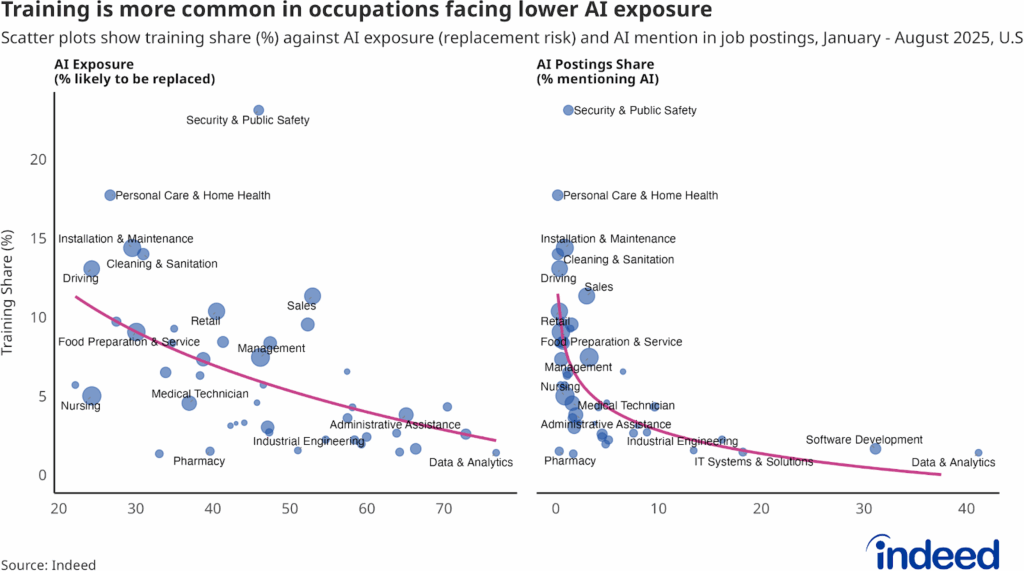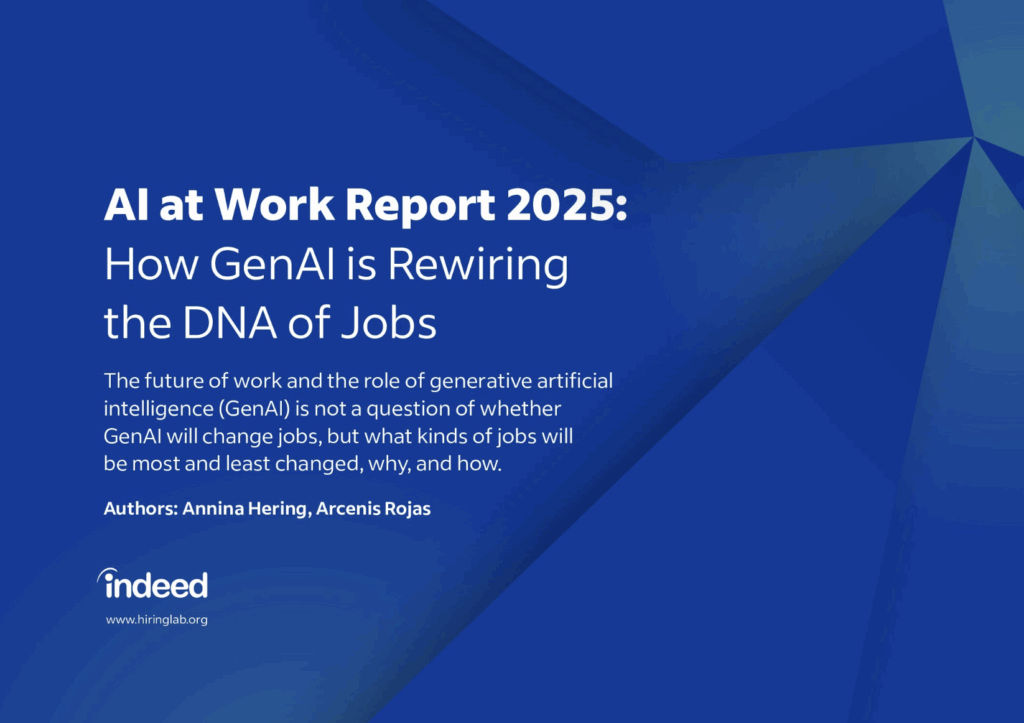Key points:
- The share of US job postings mentioning training programs rose from 3.4% in January 2018 to 8.1% in August 2025.
- Training offers are most common in occupations like security & public safety and personal care & home health, while they are rare in technical and higher education occupations like data analytics and software development.
- Training opportunities cluster in jobs requiring lower education, experience, and wages, as well as jobs that have lower AI exposure and adoption.
For many workers, the first years of employment are as much about learning as about earning. Skills are often built on the job through structured programs, informal coaching, and learning-by-doing. But as AI begins to reshape entry-level roles, the pathways through which people acquire skills may themselves be at risk.
To better understand this dimension of the labor market, Hiring Lab measured the share of job postings on Indeed that explicitly mention on-the-job training opportunities, enabling us to track how employers communicate their willingness to invest in skill development.
Training offers are on the rise
Employer-provided training has become more visible in recent years. Indeed data shows that 8.1% of US postings in August 2025 mentioned training programs, a 2.4x increase over 8 years.

This upward trend is not simply the result of changes in the occupational mix of job postings. Recalculating with 2019 occupational weights yields a similar increase. In other words, the rise reflects a broad-based shift in employer posting behavior across occupations, not just growth in occupations more likely to mention training.
While the data clearly shows a substantial increase in training mentions, the underlying drivers are harder to pin down. Employers may genuinely be expanding training in response to skill shortages. But other factors could also play a role, including regulatory changes requiring new certifications or disclosure about training, HR strategies that view training offers as competitive recruitment advantages, and/or a shift toward being more explicit in job postings about benefits already offered. It is difficult to disentangle how much of the training mentioned in postings is just about day one onboarding vs. longer-term training, but it is clear that the frequency of training mentions varies strikingly across occupations.
On-the-job training differences across occupations
In 2025, security & public safety and personal care & home health topped the list of occupations with the highest shares of postings offering some form of on-the-job training, with more than one in five postings in these occupations explicitly mentioning training opportunities. An example of a job posting in the security field included this description: “What We Offer: Competitive salary. Comprehensive paid training program. Great company culture.” A posting for a personal care role noted, “No experience is required to start because we offer free training to earn your home health aide certificate.”
In contrast, technical and high-skill professional roles — including for data & analytics and physicians & surgeons jobs — tend to offer fewer training opportunities. These are postings for jobs that typically require certain specific skills, obtained via education and/or after years of professional experience, leaving less need for explicit employer-led training. Employers might also expect higher-paid workers to take greater responsibility for their own training. Training in these kinds of roles also tends to be more general than specific, and employers have less of an incentive to provide training that workers will be able to use at other firms. When they do offer training, an example from a software development job looked like this: “$5,500 and 40 hours of paid training each year.”

Offers for explicit on-the-job training appear to be concentrated in occupations where employers expect to onboard candidates with limited credentials and build skills internally. Occupations with lower average education requirements, less experience demanded, and lower wages all exhibit higher training shares.

How does AI affect training?
Another dimension is how training intersects with AI. Earlier Hiring Lab research and the Indeed AI Tracker measure AI exposure (the likelihood that tasks could be affected by AI) and AI adoption (the share of job postings mentioning AI), respectively. Linking these measures shows that both AI-exposure and AI-adoption are negatively correlated with training — training opportunities decline the more exposed a role is to AI transformation and/or the higher the adoption rate of AI is in a given industry.

This broad negative correlation highlights a tension: the roles most likely to be reshaped by AI are also the ones where employers appear least inclined to advertise training, potentially limiting workers’ ability to adapt as technologies evolve. Higher-paying, higher-skilled roles are often more exposed to AI, and these are the roles where training also happens to be less frequently advertised to prospective employees.
Conclusion
Over the past eight years, explicit mentions of training in US job postings have risen, but training remains unevenly distributed across occupations: more common in lower education, lower experience, lower wage jobs, and in roles less exposed to AI. The data reveals a mismatch: employers advertise training least in fields where AI disruption may make such support most critical.
Methodology
Training refers to types of training explicitly stated as being provided by the employer. This includes on-the-job training (OJT) as well as training programs offered at no cost to the worker or where all training-related expenses are fully covered.
Education required is measured by assigning years to each education level (e.g., middle school = 8 years, bachelor’s degree = 16 years, etc.) and taking the average. Experience required is measured by assigning 0 for no experience required and using the minimum required years for all others, then taking the average. AI exposure is the proportion rated “Very likely” or “Likely” exposed to AI in Hiring Lab research.


